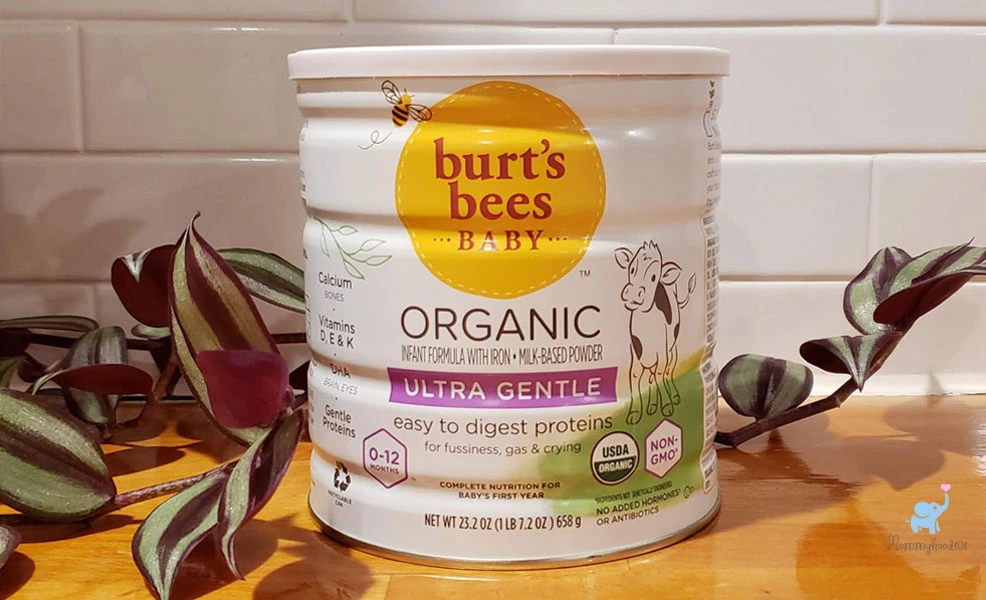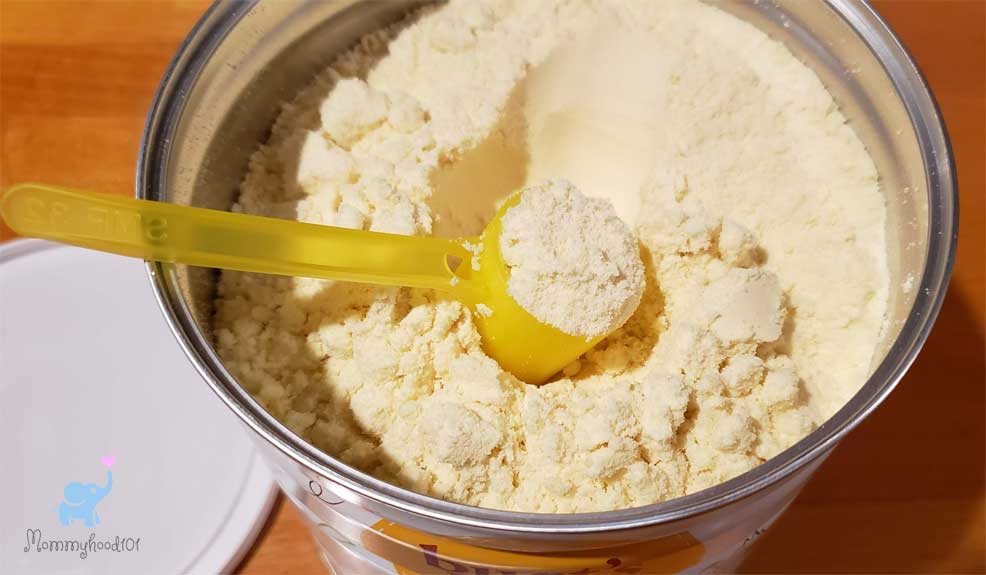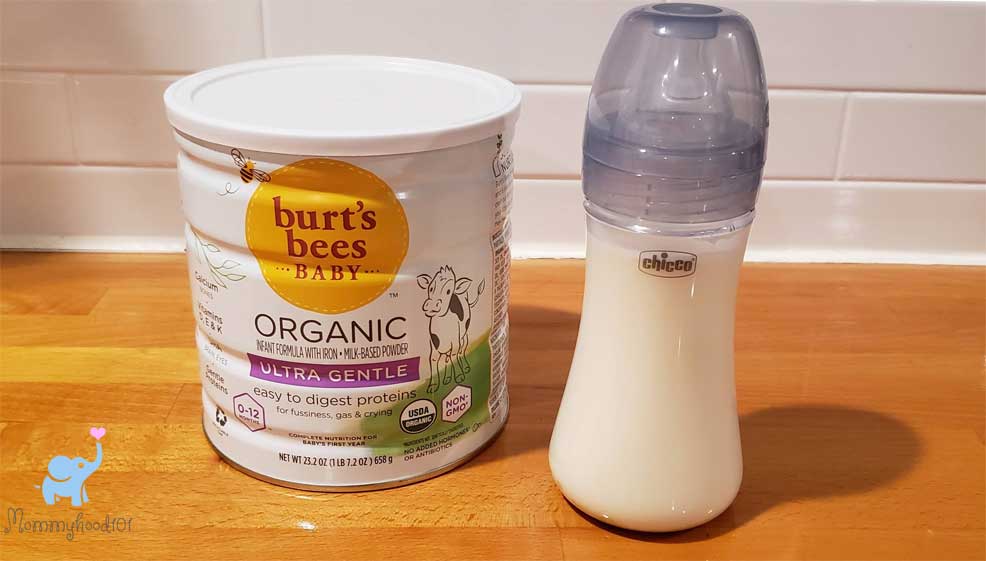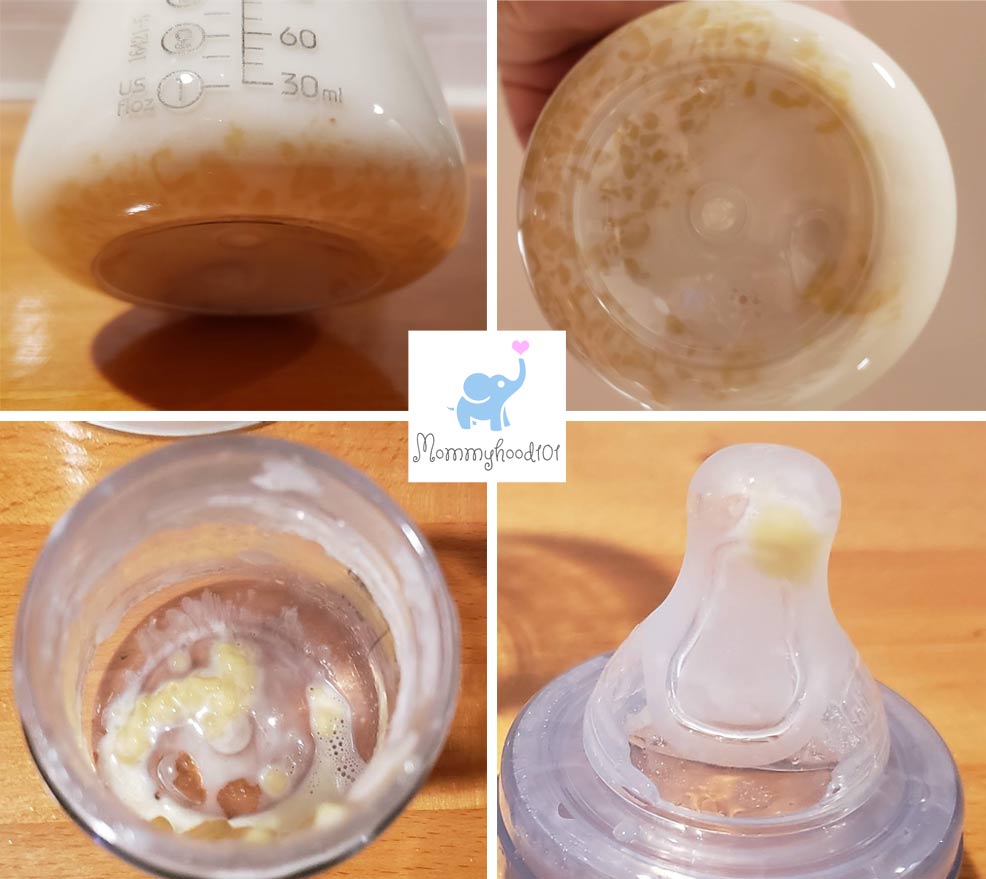Is this new organic formula the bee's knees? We put it to the test to find out.

Mommyhood101 independently tests and curates baby gear to help you make informed decisions. If you buy products through links on our site, we may earn a commission.
Update: We're sad to announce that the Burt's Bees infant formula was discontinued in late 2022. For other great alternatives, check out our list of the best organic baby formulas!
We all know and love Burt's Bees for their personal care products, including lip balms and lotions, all containing a hint of beeswax for an appealing aroma.
Well, Burt's Bees just released an awesome new organic baby formula, and we're excited to be the first to test it out!
The American baby formula market is exploding with new organic formula options, and Burt's Bees jumped into the competition with an organic and ultra-gentle baby formula that claims to be easy to digest and provide complete nutrition for a baby's first year (0-12 months).
Burt's Bees is making three formula varieties: regular, sensitive, and ultra-gentle. We tried out all three to give you a comprehensive understanding of the range of options.
On paper, they look pretty great, with no added hormones, antibiotics, preservatives, or genetic engineering. But that's never enough to satisfy us - we needed to put them to the test!
To review the Burt's Bees baby formulas, we tested them with two infants (2 months and 7 months), and consulted with a developmental nutritionist to assess ingredients and nutritional contents relative to USDA and FDA guidelines.
Spoiler alert!
In a market increasingly saturated by European baby formula options, such as those by Loulouka, HiPP, Holle, Kendamil, and Lebenswert, Burt's Bees is a welcome new addition from a US manufacturer.
There's a lot to love about this formula, including its organic ingredients and nutritional composition, and we are super excited to have a new option on the US market!
The Burt's Bees formula is great as a relatively sensitive formula for newborns and infants alike, showing high acceptance and tolerance. It's reasonably priced and the nutrition is top-notch.
However, we did find some cons that are worth pointing out, mostly related to ingredients and preparation.
Is it good enough to be included on our list of the best organic baby formulas? Definitely, but not in a top position.
Overall, we give the Burt's Bees formula a 4.1 out of 5, which puts it in direct competition with some of the popular European brands. Keep reading to see how we reached these conclusions!
-
- Burt's Bees Formula Comparison
- Take-Home Message
- Burt's Bees Manufacturing Practices
- US Organic Farming
- Burt's Bees Ingredients
- Burt's Bees Infant Milk Ingredients
- Burt's Bees Ultra Gentle Ingredients
- Burt's Bees Sensitive Ingredients
- Burt's Bees Options: Ingredient Differences
- Burt's Bees Nutritional Analysis
- USDA & FDA Formula Recommendations
- Burt's Bees Formula Testing in Infants
- Conclusions
- Where to Buy Burt's Bees Formulas
- References Cited
| Burt's Bees Infant Milk Formula (0-12 mo) | |
| Burt's Bees Ultra Gentle Formula (0-12 mo) | |
| Burt's Bees Sensitive Formula (0-12 mo) |
Burt's Bees Organic Formulas: Take-home Message
Most people don't want to read this entire article to see what we found. So here is the summary of what we loved, and what we didn't.
✔️ High-quality organic formulation.
✔️ Nutrition at FDA & USDA standards.
✔️ First ingredient is lactose.
✔️ Nothing artificial.
✔️ DHA not extracted with hexane.
✔️ No maltodextrin or starch (except in Sensitive).
✔️ No sucrose or glucose syrups solids (except in Sensitive).
✔️ Gluten-free.
✔️ Omega-3 via DHA.
✔️ Omega-6 via ARA & LA.
✔️ Inositol & Choline.
✔️ Amino Acids (taurine).
✔️ High infant acceptance.
✔️ No gas, indigestion, or constipation.
✔️ Prebiotics via FOS (except in Ultra Gentle).
❌ No probiotics.
❌ Mortierella Alpina Oil.
❌ Schizochytrium Sp. Oil.
❌ Palm Oil and Soy Oil.
❌ Maltodextrin in Sensitive Version.
❌ Syrup Solids in Sensitive Version.
❌ Poor Mixing & Clumping.
Overall, we think there is a lot to love about the new Burt's Bees organic baby formulas, especially when it comes to ingredients and nutritional composition. Regarding ingredients there is one exception: the Sensitive version replaces lactose with some suboptimal ingredients (glucose syrup solids, maltodextrin), which is unfortunate.
The worst aspect, in our experience, was the mixing: we had a really hard time getting the formulas to mix well with water, and had major issues with clumping. In fact, the clumps were so big and unruly that they ended up clogging the nipples of our baby bottles. Not good! Read through our entire review to see the details and photos!

Burt's Bees Formulas: Best Practices?
Burt's Bees was founded in Maine, USA, in the 1980's, using leftover beeswax from a beekeeper named Burt. They started with candles and then expanded into personal care items including lip balms and soaps.
In 2007, Burt's Bees was purchased by Clorox, a large multinational manufacturer of chemical and personal care products.
Following the acquisition, Burt's Bees saw a period of rapid growth and expansion due to Clorox continuing to honor the company's vision of natural and sustainable products, and pushing funds into large marketing campaigns.
In mid-2021, Burt's Bees made a licensing agreement with a large pharmaceutical company, called Perrigo, to sell their baby formulas under the Burt's Bees brand.
The Burt's Bees products are fully manufactured by Perrigo Company, based in Allegan, Michigan. Perrigo has a long history of making infant formulas, namely their Organic, Advantage, and Gentle baby formulas that serve as a genetic alternative to Similac brands.
You may have seen their brands labeled as "Love & Care" on Amazon or elsewhere:

Perrigo Nutrition manufactures baby formulas in Vermont following a rigorous set of standards and certifications. These include not only compliance with FDA regulations, but also certification as an ISO 9001 facility, Safe Quality Food Program, and Quality Assurance International.
That's a lot of certifications! At their factory in Vermont, they conduct over 2500 different tests of baby formulas per month, ensuring quality compliance and reliability.
All told, while Perrigo is a large company that produces (and rebrands) generic baby formulas, they do appear to follow a rigid set of standards and certifications.
Unlike EU organic certification, the Perrigo organic certifications are not completely transparent so ingredient traceability can be challenging.
We do know that the Burt's Bees formulas meet USDA organic requirements and certification, which means they contain a minimum of 95% organic content. But we do not know where the ingredients are sourced, or how they are processed and treated.
Burt's Bees Formula Ingredients
The ingredient sourcing for Burt's Bees formulas is not as transparent as some brands, such as Löwenzahn but we assume they are sourced from both US and non-US farms and other sources.
The use of ingredients sourced from organic farms provides some intangible benefits for the quality of infant and toddler formulas, but we cannot guarantee that is the case with these ingredients.
While these benefits may not appear on an ingredients label, this usually means that there is a lower risk of the products containing all the nasty stuff you don't want to occur (even in trace amounts), like pesticides, herbicides, antibiotics, or heavy metals.
Here are the ingredients in each of the Burt's Bees baby formulas (as of late-2021 manufacturing date):

Burt's Bees Infant Milk Formula Ingredients: organic lactose, organic nonfat milk, organic palm oil or palm olein, organic soy oil, organic coconut oil, organic high oleic (safflower or sunflower) oil, organic whey protein concentrate, less than 1%: mortierella alpina oil**, schizochytrium sp. oil*, fructooligosaccharide, organic soy lecithin, ascorbyl palmitate, mixed tocopherol concentrate, calcium hydroxide, calcium phosphate, cupric sulfate, ferrous sulfate, magnesium phosphate, manganese sulfate, potassium bicarbonate, potassium chloride, potassium iodide, sodium citrate, sodium selenite, zinc sulfate, ascorbic acid, beta-carotene, biotin, calcium pantothenate, choline bitartrate, cyanocobalamin, folic acid, inositol, niacinamide, pyridoxine hydrochloride, riboflavin, thiamine hydrochloride, vitamin a palmitate, vitamin d (cholecalciferol), vitamin e (dl-alpha tocopheryl acetate), vitamin k (phytonadione).
**A source of arachidonic acid (ARA)
*A source of docosahexaenoic acid (DHA)
Burt's Bees Ultra Gentle Formula Ingredients: organic lactose, organic partially hydrolyzed whey protein, organic palm oil or palm olein, organic soy oil, organic coconut oil, organic high oleic (safflower or sunflower) oil, less than 1%: mortierella alpina oil**, schizochytrium sp. oil*, vitamin a palmitate, beta-carotene, vitamin d (cholecalciferol), vitamin e (dl-alpha tocopheryl acetate), mixed tocopherol concentrate, vitamin k (phytonadione), ascorbyl palmitate, thiamine hydrochloride, riboflavin, pyridoxine hydrochloride, cyanocobalamin, niacinamide, folic acid, calcium pantothenate, biotin, ascorbic acid, choline bitartrate, inositol, calcium carbonate, calcium chloride, calcium hydroxide, ferrous sulfate, zinc sulfate, manganese sulfate, cupric sulfate, magnesium chloride, potassium bicarbonate, potassium phosphate, potassium hydroxide, potassium iodide, sodium selenite, sodium citrate, taurine, organic soy lecithin.
**A source of arachidonic acid (ARA)
*A source of docosahexaenoic acid (DHA)
Burt's Bees Sensitive Formula Ingredients (translated): organic nonfat milk, organic glucose syrup solids, organic maltodextrin, organic palm oil or palm olein, organic soy oil, organic coconut oil, organic high oleic (safflower or sunflower) oil, organic whey protein concentrate, less than 1%: mortierella alpina oil**, schizochytrium sp. oil*, fructooligosaccharide, organic soy lecithin, ascorbyl palmitate, mixed tocopherol concentrate, calcium hydroxide, calcium phosphate, cupric sulfate, ferrous sulfate, magnesium phosphate, manganese sulfate, potassium bicarbonate, potassium chloride, potassium iodide, sodium citrate, sodium selenite, zinc sulfate, ascorbic acid, beta-carotene, biotin, calcium pantothenate, choline bitartrate, cyanocobalamin, folic acid, inositol, niacinamide, pyridoxine hydrochloride, riboflavin, thiamine hydrochloride, vitamin a palmitate, vitamin d (cholecalciferol), vitamin e (dl-alpha tocopheryl acetate), vitamin k (phytonadione).
**A source of arachidonic acid (ARA)
*A source of docosahexaenoic acid (DHA)
Here are some ingredients that we did not find in any varieties of Burt's Bees formula: starch, artificial colors, artificial flavors, preservatives, sucrose, gluten, genetically modified organisms (GMOs), carrageenan, or high fructose corn syrup.
Some questionable ingredients:
Schizochytrium Sp. Oil: There are basically two primary ways to get DHA (docosahexaenoic acid, an important Omega-3 fatty acid found in breast milk) into baby formula. The first is by adding fish oil, and the second is by adding algae oil. Burt's Bees decided to add algae oil, specifically schizochytrium sp. oil, which is oil extracted from freshwater microalgae. This oil is an excellent source of DHA, containing up to 40% DHA content. While some baby formula manufacturers use potentially hazardous chemicals to extract DHA from this oil, such as hexane, Burt's Bees discloses that they do not use hexane in their extraction process. So while we prefer the use of DHA from fish oil, this ingredient seems OK.
Mortierella Alpina Oil: This oil is an excellent source of ARA (arachidonic acid, an important Omega-6 fatty acid found in breast milk), which most adults introduce into their diets through eggs, poultry, and meat. Mortierella Alpina is a fungus that is fermented and has an ARA-rich oil extracted from it. Mortierella Alpina oil is considered generally safe for infant consumption, though there has been some controversy (particularly among parents reporting diarrhea and other symptoms) surrounding its use.
Palm Oil or Palm Olein: When an ingredients label says something like "palm oil OR palm olein" we always raise our eyebrows. Which one is it, and why don't you know!? Palm oil is very common in baby formula, used primarily to mimic the high levels of Palmitic Acid naturally found in breast milk. Palmitic acid is the major saturated fatty acid found in breast milk, accounting for about 20-25% of breast milk fatty acids. However, palm oil and palm olein have a different molecular structure (the fatty acids are on a different position on the triacylglyceride) than Palmitic Acid, altering their metabolism and effects on the body. Recent research suggests that palm oil and palm olein can cause loose stools and limit the absorption of fat, DHA, palmitate, and calcium (see reference section). For those reasons, we prefer baby formulas that do not use palm oil or palm olein.
Soybean Oil: Some parents get concerned about soy oil due to fear of residual pesticides from farming practices, genetic modification or crop engineering, or hydrogenation of the soy oils (which can produce trans fats). However, the fact that Burt's Bees formulas contain organic soybean oil should mitigate these fears. Also, note that there is no evidence of phytoestrogens being present in soy oils, so there are none of the typical concerns about estrogen-like compounds altering reproductive system development.

Glucose Syrup Solids: The Sensitive version of Burt's Bees contains glucose syrup solids as a primary source of carbohydrates (sugars). This addition was necessary due to the omission of lactose, which is the most common carbohydrate source in baby formula (and breast milk!). In these cases, most baby formula brands end up replacing lactose with maltodextrin, sucrose, brown rice syrups, or corn syrup solids. Note that corn syrup solids are actually banned for use in infant formulas by the European Commission, but not in the US. While all of these carbohydrate sources have a very high glycemic index (except for maltodextrin, which is even higher than these other glucose sources), and we prefer not to see them in baby formula, realistically they're all similarly questionable and we have no strong preference for one versus the other. Glucose syrup solids are typically made from corn or rice, but Burt's Bees doesn't disclose the source, making it hard to know whether they are actually using corn syrup solids.
Maltodextrin: The Sensitive version of Burt's Bees also contains maltodextrin as another carbohydrate source. Just as we discussed with glucose syrup solids, maltodextrin is a common carbohydrate supplement (usually alongside a primary carbohydrate source) in lactose-free baby formulas. Maltodextrin is also used as a thickener. We prefer that maltodextrin is avoided completely due to its very high glycemic index, though it is considered safe in small quantities.
Some other ingredients worth mentioning:
Prebiotics via FOS: These are fructooligosaccharides (FOS), which are dietary prebiotics that help promote a healthy gut microbiome through benefits to intestinal microbiota and gut barrier function. Research shows that prebiotics in infant formula are beneficial for digestion and reducing the rates of gas and colic (and they are more effective than probiotics, see references).
Fluoride: Burt's Bees doesn't add fluoride to their formulas like some others (like we saw in our Kendamil formula review), though it is likely naturally present in small amounts (though that isn't indicated on the nutritional label).
Burt's Bees Formulas: Ingredient Differences
1. Burt's Bees Infant Milk vs Ultra Gentle: There is one main difference between these formulas. While the Infant milk uses lactose and nonfat milk as the first two ingredients, the Ultra Gentle version uses lactose and partially hydrolyzed whey protein. Both nonfat milk and whey protein provide a decent protein source, but the partially hydrolyzed proteins are broken down for easier digestion. If your baby has a more sensitive tummy, this could help them digest the formula more easily.
2. Burt's Bees Ultra Gentle vs Sensitive: While the Ultra Gentle version replaces nonfat milk with partially hydrolyzed whey protein to ease digestion, the Sensitive variety goes a step further by removing lactose entirely. If you and your doctor agree that your baby should try a lactose-free baby formula, the Burt's Bees Sensitive variety might be a good option. However, when you remove the primary carbohydrate source in baby formula (lactose), you need to replace it with another carbohydrate. Burt's Bees chose to replace it with glucose syrup solids and maltodextrin, both of which we consider unpreferred ingredients.

Burt's Bees Formula Nutritional Analysis
To examine whether Burt's Bees baby formulas come close to the stringent nutritional recommendations put forth by the US Department of Agriculture (USDA, see references), Food and Drug Administration (FDA), and American Academy of Pediatrics (AAP), we consulted with a dietician nutritionist with expertise in infant feeding (Mr. John Anderson).
Note that the FDA publishes guidance in 21 U.S. Code 350a regarding nutrient requirements in infant formula. This regulation includes minimum protein, fat (and fatty acid linoleate) content. It also includes ranges for 15 vitamins and 11 minerals.
Here are the FDA requirements per 100 kilocalories of formula (see references):
FDA Nutritional Requirements:
| Protein | 0-6mo: 1.8g to 4.5g |
| Fat | 0-6mo: 3.3g to 6.0g (≥ 30% of calories) |
| Essential Fatty Acid (LA Omega-6) | 0-6mo: ≥300mg (≥2.7% of calories) |
| Vitamin A | 0-6mo: 250IU to 750IU (75-225μg if retinol) |
| Vitamin D | 0-6mo: 40IU to 100IU |
| Vitamin K | 0-6mo: ≥4μg |
| Vitamin E | 0-6mo: 0.7IU |
| Vitamin C | 0-6mo: ≥8mg |
| Vitamin B1 | 0-6mo: ≥40μg |
| Vitamin B2 | 0-6mo: ≥60μg |
| Vitamin B6 | 0-6mo: ≥35μg |
| Vitamin B12 | 0-6mo: ≥0.15μg |
| Niacin | 0-6mo: ≥250μg |
| Folic Acid | 0-6mo: ≥4μg |
| Pantothenic Acid | 0-6mo: ≥300μg |
| Biotin | 0-6mo: ≥1.5μg (for non-milk-based formulas) |
| Choline | 0-6mo: ≥7mg (for non-milk-based formulas) |
| Inositol | 0-6mo: ≥4mg (for non-milk-based formulas) |
| Calcium | 0-6mo: ≥50mg |
| Phosphorus | 0-6mo: ≥25mg |
| Magnesium | 0-6mo: ≥6mg |
| Iron | 0-6mo: ≥0.15mg |
| Iodine | 0-6mo: ≥5μg |
| Zinc | 0-6mo: ≥0.5mg |
| Copper | 0-6mo: ≥60μg |
| Manganese | 0-6mo: ≥5μg |
| Sodium | 0-6mo: 20mg to 60mg |
| Potassium | 0-6mo: 80mg to 200mg |
| Chloride | 0-6mo: 55mg to 150mg |
In our review of the Burt's Bees formulas, we found that all three varieties met all of the minimum FDA nutritional requirements (and did not exceed any of their maximums).
The USDA does not publish recommended daily allowances (RDAs) for infants between 0-6 months. Instead, they publish information about Adequate Intake (AI), which is used when there is not enough evidence to make a formal RDA. The AI is set at a level assumed to provide nutritional adequacy.
Here are the USDA's AIs (per day) for infants aged 0-6 months, and 6-12 months. Units are grams (g), milligrams (mg), micrograms (μg).
USDA Nutritional Recommendations:
| Carbohydrates | 0-6mo: 60g | 6-12mo: 95g |
| Proteins | 0-6mo: 9.1g | 6-12mo: 11g |
| Fats | 0-6mo: 31g | 6-12mo: 30g |
| Omega-3 | 0-6mo: 0.5g | 6-12mo: 0.5g |
| Omega-6 | 0-6mo: 4.4g | 6-12mo: 4.6g |
| Vitamin A | 0-6mo: 400μg | 6-12mo: 500μg |
| Vitamin B1 | 0-6mo: 0.2mg | 6-12mo: 0.3mg |
| Vitamin B2 | 0-6mo: 0.3mg | 6-12mo: 0.4mg |
| Vitamin B6 | 0-6mo: 0.1mg | 6-12mo: 0.3mg |
| Vitamin B12 | 0-6mo: 0.4μg | 6-12mo: 0.5μg |
| Vitamin C | 0-6mo: 40mg | 6-12mo: 50mg |
| Vitamin D | 0-6mo: 5μg | 6-12mo: 5μg |
| Vitamin E | 0-6mo: 4mg | 6-12mo: 5mg |
| Vitamin K | 0-6mo: 2μg | 6-12mo: 2.5μg |
| Folate | 0-6mo: 65μg | 6-12mo: 80μg |
| Niacin | 0-6mo: 2mg | 6-12mo: 4mg |
| Calcium | 0-6mo: 210mg | 6-12mo: 270mg |
| Iron | 0-6mo: 0.27mg | 6-12mo: 11mg |
The Burt's Bees formulas meet all of the USDA recommendations, not surprisingly.
The only challenge was figuring out exact Omega-3 and Omega-6 contents.
The nutrition facts does disclose that each 100kcal for formula contains 750mg of linoleic acid, which is an Omega-6 fatty acid. However, we also know that the formulas contain ARA, another Omega-6 fatty acid, but the amount is not disclosed on the nutrition label. Similarly, we also know that the formulas contain DHA, an Omega-3 fatty acid, but the amount is not disclosed on the nutrition label. Note that disclosing these amounts on a nutrition label is not required in the USA (it's only required for linoleic acid).
Burt's Bees Testing in Infants
We tested the Infant Milk, Ultra Gentle, and Sensitive formulas in a newborn (5 weeks) breastfed baby and a 2-month-old formula-fed baby (he typically feeds with Loulouka).
Mixing and Taste-Testing
At first, Burt's Bees seems to mix very easily with warm water (they say to use water at about 100 degrees F): there wasn't any foaming or dramatic bubbling after a vigorous shaking, which is always a good sign.
To prepare the formula, we followed the instructions: Wash hands, surface, and utensils. Pour the desired amount of warm water (at 100 deg F, or 40 deg C) into a clean bottle. Using the feeding chart, add the appropriate amount of formula (using the included scoop).
Here is what the formula and scoop looked like:
This is a trivial point, but we were a little annoyed when we first opened the tin of baby formula, for two reasons. First, there was no built-in ledge to help you make level scoops, which is common with many other brands (and super convenient!). Second, the scoop was nowhere to be found, we had to dig around in the formula with a fork to fish it out! A little frustrating, but again not a huge deal.
Next, once you've added the appropriate number of scoops of formula, close the bottle and shake well until the formula is dissolved.
Feed immediately, and discard any remaining prepared formula that isn't consumed within 1 hour of starting to feed.
At first glance, the mixing went well, and things were looking great. Here is a photo from the Ultra Gentle preparation:
Notice how the bubbles and foam settled very nicely after mixing? That's what we like to see!
Want to learn more about that Chicco bottle? Check out our Chicco Duo review, and our list of the Best Baby Bottles of the year!
Once we picked up the bottle for feeding and flipped it over, this is where the issues started.
We noticed a ton of yellow clumping on the bottom of the bottle, suggesting that we hadn't sufficiently mixed the formula.
So we prepared all three formulas again, ensuring the water was exactly 100 degrees (F), and shaking the bottles for over 2 minutes each.
Here is what the bottles looked like:
These clumps were especially a problem when the Infant Milk and Ultra Gentle varieties.
At first, we thought that it wouldn't be an issue until we realized that at one point it was even clogging the nipple (see the lower right photo, above)!
Not only was this a little bit disgusting, it was also a total nuisance for feeding and cleanup.
Safety First: Never prepare powdered formula with anything but water. If you're interested in fortifying your breast milk with formula you must ask your doctor for guidance first, as this can be very dangerous for your baby.
Feeding with Burt's Bees
Due to the issues with clumping, we were tempted to strain the formula before testing it on the two babies. Of course, we don't recommend ever filtering or straining a formula because it could remove essential nutrients, alter the nutritional profile, and change the texture and consistency.
So we decided to feed with the three bottles as-is, risking that the clumps would end up clogging the nipples.
Well, one of the bottles clogged within a few minutes of feeding (the Ultra Gentle), so we needed to scrap that idea.
When testing the Infant Milk and Sensitive varieties, both had some clumping as well, but it didn't end up clogging a nipple.
With those, both babies took to the bottles without issue and seemed to appreciate the taste. We tasted them ourselves and found them somewhat bland, certainly not as flavorful as some other baby formulas we've tested! But they were accepted by the two test babies pretty readily.
We should point out that both parents who helped us in our testing were a little grossed out by the clumping and were hesitant to try feeding with the Burt's Bees formulas.
In the short- and long-term, neither of the infants developed any apparent gas or indigestion (or spit up!), at least not more so than their usual levels.
Conclusions
This was our first time trying out the new Burt's Bees infant formulas and we were really excited to give them a shot!
As you know, we are on an eternal mission to find the best organic baby formulas, and were really hoping that this option from Burt's Bees would end up a front-runner.
In terms of ingredients and nutritional contents, we think the Burt's Bees options are great, especially the Infant Milk and Ultra Gentle varieties. The Sensitive variety leaves a little something to be desired in the ingredients department, especially given the addition of maltodextrin and glucose syrup solids.
The worst aspect of these formulas, in our experience, was in preparation and feeding. All three of the formula versions ended up with serious clumping that not only sat at the bottom of the bottle during mixing but also ended up clogging the bottle nipples during feeding.
This was really disappointing! Overall, we were left with mixed impressions (no pun intended) of Burt's Bees formulas. On the one hand, we love that more companies are venturing into the organic baby formula space, giving parents more options than the typical European formulas. And we also thought the ingredients and nutrition were pretty good, with some minor exceptions with the Sensitive variety.
But on the other hand, we were disappointed with the preparation and feeding. Even though our test babies seemed to accept and appreciate the taste of the formulas, it was nearly impossible to effectively feed them when we had clumps falling into the nipple.
We hope that Burt's Bees will change their formulation to help the formula dissolve better into the water and avoid clumping! If so, we'll be back to test the new version and let you know how it does.
Where to Buy Burt's Bees Formulas?
Unfortunately, Burt's Bees baby formulas have been discontinued!
You can no longer find them at retailers, and any old inventory is likely expired.

References Cited
Intestinal Effects of Prebiotic GOS in Infant Formula
Meta-analysis of Partially Hydrolyzed Whey Protein in Baby Formulas: Effects on Allergies
Consulting Dietician Nutritionist (Mr. John Anderson)
Perrigo and Burt's Bees reach Licensing Agreement for Baby Formulas
United States FDA Infant Formula Nutrient Requirements (full list is here)
United States USDA Infant Nutritional Needs & Recommendations
Safety of Schizochytrium sp. Oil
Safety of Mortierella Alpina Oil
Palm Oil and Palm Olein in Baby Formula
Disclaimer: To our knowledge, all ingredient and nutritional information contained in this article was accurate at the time of publication. We make no guarantees regarding the accuracy or timeliness of the information. Always read the packaging and instructions, and consult with your child's pediatrician before making nutritional and feeding decisions. Baby formulas manufactured and labeled for sale in Europe may or may not be approved for sale in the USA by the FDA or other regulatory bodies, so consumer discretion is advised.








